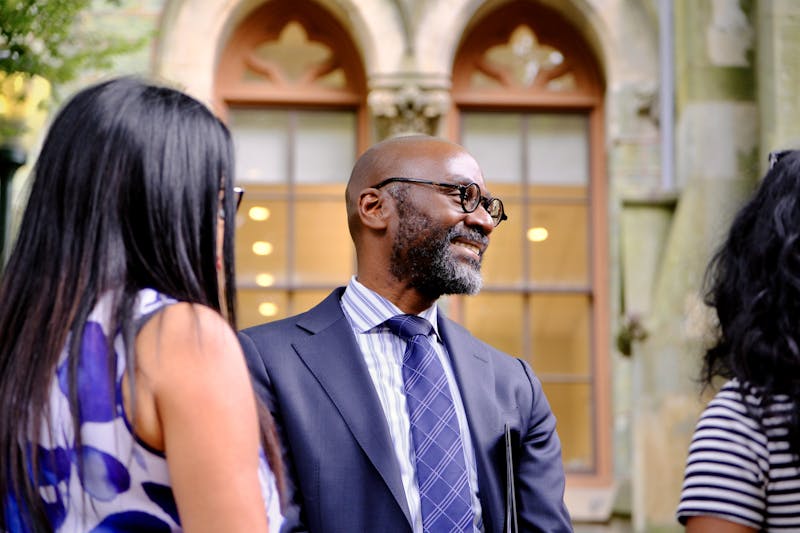The $1.2 million project includes a new workout room and aerobic space. Incoming students may have an easier time fighting the "Freshman 15" this fall. Next week, administrators will unveil one of the most eagerly anticipated campus construction projects -- the renovated Gimbel Gymnasium, which will feature a state-of-the-art, $1.2 million aerobic fitness center and weight room. Four walls of clear glass surround the 3,000-square-foot large fitness center room, which will be equipped with treadmills, bikes, stairclimbers, EFX machines and ergometers. Video monitors will fill a portion of the walls, which will also be lined with audio equipment. The second-floor of the facility will contain three interconnected workout spaces, which will combine a free weight area with selectorized equipment such as leg press, tricep and pulldown stations. The project will incorporate the facility's existing weight room, and Gimbel's swimming pool and three basketball courts will not be affected by the renovations. The renovations, completed in less than four months, will be unveiled at a grand opening September 8 attended by University President Judith Rodin and other Penn officials, student leaders and Penn parents Ellen and Howard Katz, the lead donors for the project. Currently, the building's pool remains open for use, but the new equipment will not be ready until next week and its basketball courts remain closed until September 8. The new facility will offer students "longer hours, a climate controlled facility and state-of-the-art equipment," Recreation Director Mike Diorka said. In addition to the high tech additions to Gimbel, there is also an added economic perk. Students wishing to use the Gimbel and Hutchinson facilities will have to pay $75 per year, approximately $250 less that a full two semester membership at the off-campus University City Nautilus, located at 40th and Locust streets, and $125 less than a membership for Sweat Gym at 24th and Walnut streets. With the addition of these benefits, Diorka added, "we expect Gimbel to be a more utilized recreational facility." Some students, in fact, are concerned that too many people will be attracted to the new facility. Former Undergraduate Assembly Chairperson Noah Bilenker, who made recreational facilities a major priority of his UA term, said he is concerned about overcrowding. "The old gym at Hutch was already terribly overcrowded, so this could be worse," the College senior said. The renovations at Gimbel are the result of a year and a half long study aimed at improving on-campus recreation facilities. The UA first requested changes to the gyms in 1994, although the University has been considering upgrading its fitness centers for over 30 years. In 1996, the Athletic Department hired Brailsford & Dunlavey, a Washington D.C.-based consulting firm, to recommend changes to the recreation facilities. The report, which was leaked to student government leaders in February 1998, suggested that administrators double Gimbel's existing size. Administrators released the plan in April while simultaneously announcing the Gimbel renovations. Although the Gimbel renovations are on a smaller scale than were called for in the Brailsford & Dunlavey report, which also recommended a new field house near Hutch, administrators said last spring that the new fitness center would provide a short-term fix to the shortage of recreation space. Renovations on both floors of Gimbel, as well as the installation of audio and visual systems, began in July and remained on-schedule throughout the entire process, according to Athletic Director Steve Bilsky. Although the equipment is not ready for use, the new fitness center is already generating excitement in the community. "It looks like it's going to be a really good facility and a really good place for people to work out," said Andy Fried, a third year Dental School student. College sophomore Neal Shah echoed similar positive sentiments. "I was excited about it before," he said, adding that although he rarely used Gimbel before the renovations. "I'll probably end up joining." Indeed, Diorka's experience as recreation director lent itself well to this kind of project. Diorka arrived at Penn in the fall of 1996, after an eight year stint as recreation director at Tulane University where he coordinated the construction of the Reily Student Recreation Center. Gimbel's renovations, however, recently persuaded administrators to abandon plans for an exercise facility in the rooftop lounge of Harrison House, also known as High Rise South. "We have shifted the plan a bit because of the opening of Gimbel," Associate Vice President for Campus Services Larry Moneta said in July. Although the rooftop lounge will, according to Moneta, serve "other uses by the college house system," there are plans for a small-scale fitness center in each of the high rises.
The Daily Pennsylvanian is an independent, student-run newspaper. Please consider making a donation to support the coverage that shapes the University. Your generosity ensures a future of strong journalism at Penn.
DonatePlease note All comments are eligible for publication in The Daily Pennsylvanian.







